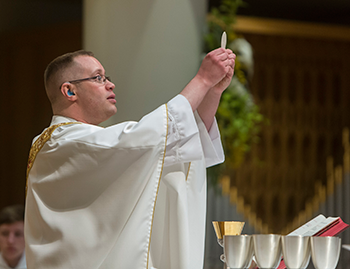Tom Larouere was used to Mass being a mumble of words.
But thanks to a new hearing assistance system, listening to the Word of God now is much clearer.
In
December, St. Patrick Parish in Wentzville installed a system that
includes a transmitter that broadcasts the church’s sound system. Users
wear a small receiver on a lanyard, which can either be plugged directly
into telecoil (t-coil) hearing aids or used with a small earpiece.
The
system with six receivers cost about $3,000, which was funded by a
Christmas and Easter car magnet fundraiser coordinated by the Knights of
Columbus Council #10154 at St. Patrick.
Father Brian Fischer,
parish pastor, noticed that most of the receivers — nine in total
including three older devices the parish already had — are being used at
Masses. Signs posted on the front doors at church let visitors know the
hearing assistance system is available. The devices also can be used
with the sound system in the church social hall.
The example
highlights the importance of churches accommodating the needs of
parishioners with hearing loss. Roughly 15 percent of adults ages 18 and
older experience hearing loss, according to data from the Centers for Disease Control and Prevention. That percentage increases as a person ages.
Larouere
has experienced hearing loss since childhood, and was fitted with
hearing aids at the age of 18. Over the years, finding the right balance
while listening in church had proven difficult. Turning up the volume
on his hearing aids also meant turning up the background noise.
He
also noted that the public’s understanding of hearing loss — including
the use of hearing aids and hearing assistance systems — has changed
over the decades. When he was younger, he didn’t want anyone to know
that he had hearing loss. He taught himself how to lip read and
generally did his best to conceal that he wore hearing aids.
When his granddaughter was fitted with hearing aids, she took a different approach, opting for a bright pink set.
 Father Dan Kavanagh, associate pastor at St. Patrick Parish in Wentzville, has used a hearing aid on and off since first grade. Father Kavanagh said it’s tough to know how many people in the parish need the upgraded hearing assistance system, but that there is definitely a need.Photo Credits: Jerry Naunheim Jr.
Father Dan Kavanagh, associate pastor at St. Patrick Parish in Wentzville, has used a hearing aid on and off since first grade. Father Kavanagh said it’s tough to know how many people in the parish need the upgraded hearing assistance system, but that there is definitely a need.Photo Credits: Jerry Naunheim Jr.“The
perception from people has changed a lot, even from when I was a kid to
now,” said St. Patrick associate pastor Father Dan Kavanagh, who has
used hearing aids on and off since the first grade, and daily since
college. He now wears a blue set, which match his blue eyes. “Some of
the kids at our school who have hearing aids, they’re very proud of
wearing them and have bright colors.”
Father Kavanagh said it’s
tough to know how many people in the parish have significant hearing
loss, but he knows there’s a need.
“It’s certainly a lot bigger
than we see at the moment,” he said. “You don’t know what you don’t
know. So if I’m struggling to hear at Mass, but I am not aware of these
devices that are out there, if I don’t go out there and do my research
or ask my audiologist, I don’t know if there’s help out there.”
For Larouere, the hearing improvement at Mass has made for a happy heart.
“Now it’s just me and the Lord,” he said with a smile.
Hearing statistics in the United States
• About 2 to 3 out of
every 1,000 children in the United States are born with a detectable
level of hearing loss in one or both ears.
• Approximately 15 percent of American adults (37.5 million) aged 18 and over report some trouble hearing.
•
Among adults aged 20-69, the overall annual prevalence of hearing loss
dropped slightly from 16 percent (28.0 million) in the 1999-2004 period
to 14 percent (27.7 million) in the 2011-12 period.
• Age is the
strongest predictor of hearing loss among adults aged 20-69, with the
greatest amount of hearing loss in the 60-69 age group.
• One in
eight people in the United States (13 percent, or 30 million) aged 12
years or older has hearing loss in both ears, based on standard hearing
examinations.
• About 28.8 million U.S. adults could benefit from using hearing aids.
Source: National Institute on Deafness and Other Communication Disorders